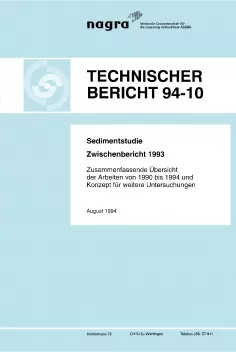
Technischer Bericht NTB 94-10
SedimentstudieZwischenbericht 1993Zusammenfassende Übersicht der Arbeiten von 1990 bis 1994 und Konzept für weitere Untersuchungen
The long-term geological investigations being carried out by Nagra as part of the high-level waste disposal programme are looking at both the crystalline basement and sedimentary formations as potential repository host rocks. The interim reports of 1988 and 1990 provided a general overview of relevant sediment options and made specific proposals for exploration strategies. This report brings together the results of investigations and studies carried out for the Opalinus Clay and Lower Freshwater Molasse options. The first part provides an overview of the results (based on key reports which have appeared since 1990), the conclusions which can be drawn and a proposal for continuation of the programme. The second part (Appendix) reproduces the most important information from the key reports in shortened form.
Seismic investigations for the Opalinus Clay option, which were carried out in the region "Nördlich Lägern – Zürcher Weinland", indicated the presence of tectonically undisturbed stratification in different parts of the region. The regionally insignificant facies variations and the thickness of the Opalinus Clay (100 – 120 m) confirm the potential suitability of this formation as a repository host rock. Nagra is of the opinion that, in areas of low tectonic activity, the Opalinus Clay represents a promising option which is relatively easy to investigate and therefore proposes starting with the next investigation phase in this formation (demonstration of siting feasibility). Explorations will be focused in the "Zürcher Weinland" (largest tectonically undisturbed area at suitable depth), but other areas to the east of the Aare can be considered as reserve options, as can the region "Jurasüdfuss – Bözberg".
The supraregional studies of the Lower Freshwater Molasse highlighted the possibilities and the limitations of interpreting existing datasets in terms of seismofacies. Although it is difficult to derive reliable information on small-scale facies variations, it is possible to distinguish clay- to marl-rich and sand-rich sequences, i.e. potentially suitable areas can be delimited: these are the "Aquitanian" of the eastern to central Plateau and the "Chattian" in the region of the Lake of Neuchatel. Based on available information, Nagra has classified the Lower Freshwater Molasse as a reserve option with a large spatial potential; there are, however, some reservations as to the explorability of safety-relevant features, namely the hydrogeology of sand-filled channels. In contrast with the Opalinus Clay, regional-scale field investigations would be necessary in the Lower Freshwater Molasse before areas could be identified for targeted site explorations.
The new results provide both a justification and a basis for continuing to explore the Opalinus Clay as the top-priority sediment host rock option. For both options, different siting alternatives have also been identified and it would be possible to fall back on these if required.
